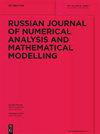ENSO phase locking, asymmetry and predictability in the INMCM Earth system model
IF 0.6
4区 数学
Q4 MATHEMATICS, APPLIED
Russian Journal of Numerical Analysis and Mathematical Modelling
Pub Date : 2024-02-10
DOI:10.1515/rnam-2024-0004
引用次数: 0
Abstract
Advanced numerical climate models are known to exhibit biases in simulating some features of El Niño–Southern Oscillation (ENSO), which is a key mode of interannual climate variability. In this study we analyze how two fundamental features of observed ENSO – asymmetry between hot and cold states and phase-locking to the annual cycle – are reflected in two different versions of the INMCM Earth system model (state-of-the-art Earth system model participating in the Coupled Model Intercomparison Project). We identify the above ENSO features using the conventional empirical orthogonal functions (EOF) analysis, which is applied to both observed and simulated upper ocean heat content (OHC) data in the tropical Pacific. We obtain that the observed tropical Pacific OHC variability is described well by two leading EOF-modes, which roughly reflect the fundamental recharge-discharge mechanism of ENSO. These modes exhibit strong seasonal cycles associated with ENSO phase locking while the revealed nonlinear dependencies between amplitudes of these cycles reflect ENSO asymmetry.We also assess and compare the predictability of observed and simulated ENSO based on linear inverse modelling. We find that the improved INMCM6 model has significant benefits in simulating described features of observed ENSO as compared with the previous INMCM5 model. The improvements of the INMCM6 model providing such benefits are discussed. We argue that proper cloud parameterization scheme is crucial for accurate simulation of ENSO dynamics with numerical climate models.INMCM 地球系统模型中的厄尔尼诺/南方涛动相位锁定、不对称和可预测性
众所周知,先进的数值气候模式在模拟厄尔尼诺-南方涛动(ENSO)的某些特征时会出现偏差,而厄尔尼诺-南方涛动是年际气候变异的一种关键模式。在这项研究中,我们分析了观测到的厄尔尼诺-南方涛动的两个基本特征--冷热状态的不对称性和与年周期的相位锁定--是如何反映在 INMCM 地球系统模式(参与耦合模式相互比较项目的最先进地球系统模式)的两个不同版本中的。我们采用传统的经验正交函数(EOF)分析方法来识别上述厄尔尼诺/南方涛动特征,并将其应用于热带太平洋的观测和模拟上层海洋热含量(OHC)数据。我们发现,观测到的热带太平洋上层海洋热含量变化可以用两个主要的 EOF 模式很好地描述,它们大致反映了厄尔尼诺/南方涛动的基本补给-排泄机制。这些模式表现出与厄尔尼诺/南方涛动相位锁定相关的强烈季节性周期,而这些周期振幅之间的非线性依赖关系反映了厄尔尼诺/南方涛动的不对称性。我们发现,与之前的 INMCM5 模型相比,改进后的 INMCM6 模型在模拟观测到的厄尔尼诺/南方涛动的描述特征方面具有显著优势。我们讨论了 INMCM6 模型的改进之处。我们认为,适当的云参数化方案对于用数值气候模式准确模拟厄尔尼诺/南方涛动动态至关重要。
本文章由计算机程序翻译,如有差异,请以英文原文为准。
求助全文
约1分钟内获得全文
求助全文
来源期刊
CiteScore
1.40
自引率
16.70%
发文量
31
审稿时长
>12 weeks
期刊介绍:
The Russian Journal of Numerical Analysis and Mathematical Modelling, published bimonthly, provides English translations of selected new original Russian papers on the theoretical aspects of numerical analysis and the application of mathematical methods to simulation and modelling. The editorial board, consisting of the most prominent Russian scientists in numerical analysis and mathematical modelling, selects papers on the basis of their high scientific standard, innovative approach and topical interest.
Topics:
-numerical analysis-
numerical linear algebra-
finite element methods for PDEs-
iterative methods-
Monte-Carlo methods-
mathematical modelling and numerical simulation in geophysical hydrodynamics, immunology and medicine, fluid mechanics and electrodynamics, geosciences.

 求助内容:
求助内容: 应助结果提醒方式:
应助结果提醒方式:


